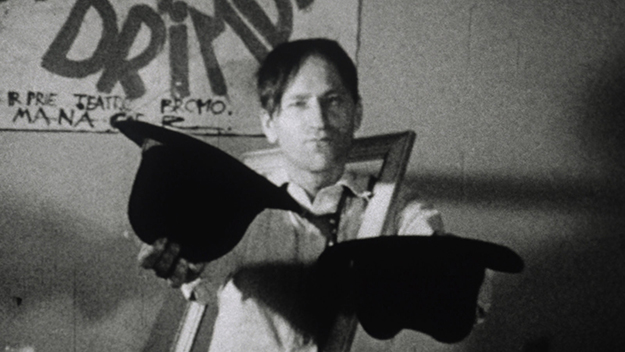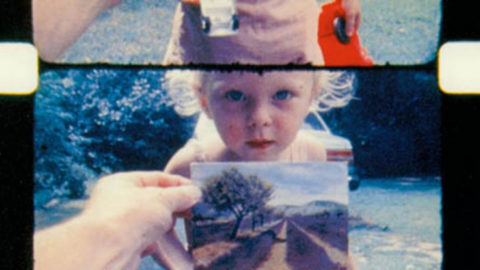Seeing Double: Lost Lost Lost and Final Destination 2
This article appeared in the March 10, 2022 edition of The Film Comment Letter, our free weekly newsletter featuring original film criticism and writing. Sign up for the Letter here.

Lost Lost Lost (Jonas Mekas, 1976)
Final Destination 2 (David R. Ellis, 2003), the second entry in the five-film horror franchise, opens with a young woman, Kimberly (A.J. Cook), packing her car to go on a trip with her friends. As the giggling crew gets on the highway, Kimberly takes note of a semi-truck nearby carrying a giant load of uncut lumber. The teens are having a typically great time—flicking joints out the window, flashing their tits, and spilling coffee on their laps—when suddenly a chain snaps on the trailer in front of them. One by one, logs thump to the asphalt and start rolling down and across the highway, setting off a massive multi-vehicle pileup—one of the most spectacular crash sequences in all of cinema, in my estimation. The mayhem climaxes with the truck smashing into the protagonist’s car. But, instead of dying in a crush of glass and metal, Kimberly wakes up and finds herself still in her car with her friends, on the same freeway, with the same semi-truck up ahead. As they drive on, events start to repeat themselves. Kimberly realizes that what she’d experienced as a dream was actually a premonition and stops her car from entering the highway just before the deadly accident happens.
During the third reel of Jonas Mekas’s Lost Lost Lost (1976)—a three-hour rumination on his displacement from Lithuania during World War II and subsequent experience of finding his way in New York City—the filmmaker pulls away from the details of his life in exile to share images and ideas from an early, abandoned narrative film project. The title card reads: “From an Unfinished Film.” As images of a woman in New York City begin to unfold, Mekas narrates, with his characteristic accent and speech patterns:
She gets up in the morning.
She walks out into the street.
And suddenly, she sees, or imagines.
The woman is back in her apartment.
She sees. She’s at home. Early in the morning.
She sees it all.
Later: he is in the street.
There is a car.
There is a car…
The car crashes and hits the man.
She sees it. She sees it all.
She’s awakened from her daydream by a car accident, just as she saw it, just as she saw it.
The eerie similarity of these two scenes—both featuring young women having a vision about a car crash that eventually happens in real life—could be attributed to a principle explicitly rejected in the Final Destination films: coincidence. But a compelling thread emerges from this unlikely narrative overlap about what it means to live in a world where death is always nearby. Like the rest of the franchise, Final Destination 2 centers on a group of characters who survive a deadly accident that the protagonist sees in a premonition. But Death has a plan—a final destination, so to speak—and over the course of the movie the survivors are killed, one by one, in spectacular fashion, no matter what they do to avoid their doom. Every death is expected yet visceral. It’s fun to shriek at the gory splatters of human flesh, as each new nerve-wracking set piece explores increasingly inexplicable ways in which the body can meet its ultimate fate.
Like Mekas himself, the people he films in the first two reels of Lost Lost Lost are also recently displaced from Lithuania. They find themselves on the streets of Williamsburg, Brooklyn in a limbo: they are safe, yet, according to Mekas’s narration, still haunted by the lives they left behind, and hoping for a future that no longer exists. Soon, Mekas and his brother Adolfas move away from the group to Manhattan, as if seeking an unfamiliar terrain to reflect the alienation that they feel. From here, time moves in mysterious ways, as it often does in Mekas’s films, which rely more on how the passage of time feels than any kind of straightforward chronology. People are visited, streets are wandered, protests are launched, but the specific when of it all remains… lost in the film’s timeless flow.
While Final Destination confronts death head on, Lost Lost Lost moves inversely, attempting to leave death behind in hopes of learning how to live again. There is no cathartic splat, no final destination in Mekas’s film. Everyone in (and watching) the film has no choice but to simply continue existing.
A few months after the seemingly impossible death of the eternally youthful Mekas, Anthology Film Archives (opened by the filmmaker in 1970) presented a series of his films in celebration of his life and work. Mekas’s discursive, highly personal, and diaristic films screened alongside another program: Infradestruction! (aka When Infrastructure Attacks), programmed by Electronic Art Intermix’s Rebecca Cleman and featuring a 35mm print of Final Destination 2. And so, on the evening of April 16, 2019, I found myself watching the two films back-to-back, an unexpectedly rich double bill that came together entirely as the result of… coincidence? When the third reel of Lost Lost Lost began, I turned in surprise to my friend, both of us expressing amazement at the unexpected thematic rhyme. This fortuitous pairing—two pieces of art that would never otherwise interact, suddenly finding themselves in conversation—was just part of the beauty of living in New York City. As Mekas says after the car crash in the scenes from his unfinished film:
“Of course, it was just another day in the city, it happens every day.”
Until it doesn’t, of course. A little over a year later, New Yorkers would experience a perverse twist on what happens in Lost Lost Lost, dislocated from communal city life and thrust into their homes. When the pandemic ebbed, and movie theaters finally reopened—“Spring Came Very Slowly,” as Mekas writes in an intertitle in his film—Anthology Film Archives’s first program was a double projection of their recent restoration of Paul Sharits’s Razor Blades, a film that is slightly different each time it’s projected. Razor Blades speaks to how the brain works, desperately desiring to make sense of things, and how when you place two images next to each other, they inevitably become one.
Gina Telaroli is a filmmaker, writer, and archivist raised in Cleveland, Ohio and currently residing in Manhattan. She is the co-founder of Duelle Films.




